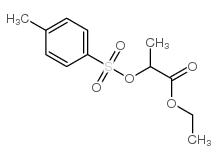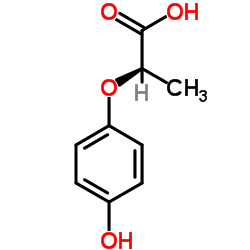quizalofop-ethyl

quizalofop-ethyl structure
|
Common Name | quizalofop-ethyl | ||
|---|---|---|---|---|
| CAS Number | 76578-14-8 | Molecular Weight | 372.80200 | |
| Density | 1.301 g/cm3 | Boiling Point | 503.9ºC at 760 mmHg | |
| Molecular Formula | C19H17ClN2O4 | Melting Point | 91.7-92.1ºC | |
| MSDS | Chinese USA | Flash Point | 100ºC | |
| Symbol |


GHS07, GHS09 |
Signal Word | Warning | |
Use of quizalofop-ethylQuizalofop-ethyl is a biochemical reagent that can be used as a biological material or organic compound for life science related research. |
| Name | quizalofop-ethyl |
|---|---|
| Synonym | More Synonyms |
| Description | Quizalofop-ethyl is a biochemical reagent that can be used as a biological material or organic compound for life science related research. |
|---|---|
| Related Catalog |
| Density | 1.301 g/cm3 |
|---|---|
| Boiling Point | 503.9ºC at 760 mmHg |
| Melting Point | 91.7-92.1ºC |
| Molecular Formula | C19H17ClN2O4 |
| Molecular Weight | 372.80200 |
| Flash Point | 100ºC |
| Exact Mass | 372.08800 |
| PSA | 70.54000 |
| LogP | 4.40590 |
| Index of Refraction | 1.604 |
CHEMICAL IDENTIFICATION
HEALTH HAZARD DATAACUTE TOXICITY DATA
|
| Symbol |


GHS07, GHS09 |
|---|---|
| Signal Word | Warning |
| Hazard Statements | H302 + H312-H400 |
| Precautionary Statements | P273-P280 |
| Personal Protective Equipment | dust mask type N95 (US);Eyeshields;Gloves |
| Hazard Codes | Xn:Harmful; |
| Risk Phrases | R21/22 |
| Safety Phrases | S22-S24/25 |
| RIDADR | UN 3077 |
| RTECS | UA2458255 |
| HS Code | 2933399024 |
|
~91% 
quizalofop-ethyl CAS#:76578-14-8 |
| Literature: KOREA RESEARCH INSTITUTE OF CHEMICAL TECHNOLOGY Patent: WO2004/2925 A2, 2004 ; Location in patent: Page 16-17 ; |
|
~64% 
quizalofop-ethyl CAS#:76578-14-8 |
| Literature: KOREA RESEARCH INSTITUTE OF CHEMICAL TECHNOLOGY Patent: WO2004/2925 A2, 2004 ; Location in patent: Page 21 ; |
|
~75% 
quizalofop-ethyl CAS#:76578-14-8 |
| Literature: Kalhor, Mehdi; Dadras, Akbar; Mobinikhaledi, Akbar; Tajik, Hassan Journal of the Chilean Chemical Society, 2011 , vol. 56, # 4 p. 833 - 836 |
| HS Code | 2933399024 |
|---|---|
| Summary | 2933399024 2-(4-((6-chloroquinoxalin-2-yl)oxy)phenoxy)propanoic acid。supervision conditions:s(import or export registration certificate for pesticides)。VAT:17.0%。tax rebate rate:9.0%。MFN tarrif:6.5%。general tariff:20.0% |
|
Differential sensitivity of lipid metabolism in monocotyledons to grass-specific herbicides.
Biochem. Soc. Trans. 21(2) , 183S, (1993)
|
|
|
Use of plant cell cultures to study graminicide effects on lipid metabolism.
Phytochemistry 63(5) , 533-41, (2003) Graminicides belonging to the cyclohexanedione and aryloxyphenoxypropionate classes are well established to act by disrupting acyl lipid biosynthesis via specific inhibition of acetyl-CoA carboxylase.... |
|
|
Effects of water management and herbicide treatments on red rice control.
Meded. Rijksuniv. Gent. Fak. Landbouwkd. Toegep. Biol. Wet. 67(3) , 441-9, (2002) Two field experiments were conducted in 1999 and 2000 at Zeme (Pavia, Italy) to determine the effects of water managements and herbicide treatments on red rice control. In the first experiment, all pl... |
| ethyl (2RS)-2-[4-(6-chloroquinoxalin-2-yloxy)phenoxy]propionate |
| rac-ethyl (2R)-2-{4-[(6-chloroquinoxalin-2-yl)oxy]phenoxy}propanoate |
| MFCD00128062 |
| ethyl 2-[4-[(6-chloro-2-quinoxalinyl)oxy]phenoxy]propanoate |
| Quizalofop-ethyl |
| Quizalofop ethyl |

![6-CHLORO-2-[(4-HYDROXYPHENYL)OXY]QUINOXALINE structure](https://image.chemsrc.com/caspic/196/76578-79-5.png)




